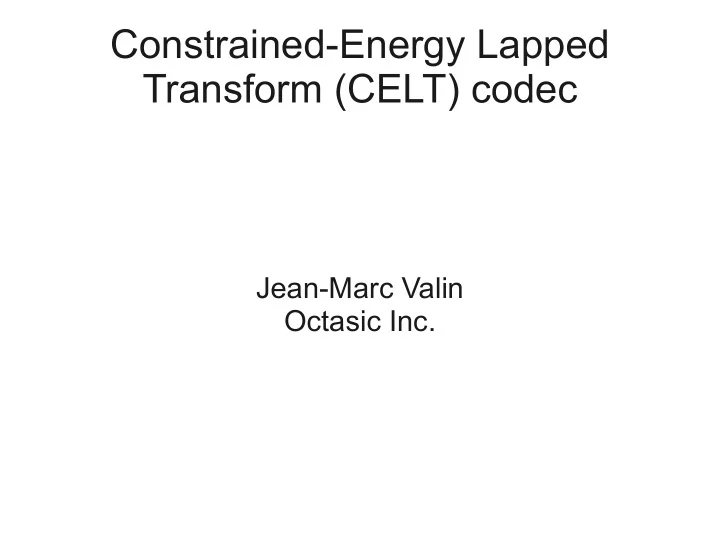

Constrained-Energy Lapped Transform (CELT) codec Jean-Marc Valin Octasic Inc.
CELT Characteristics ● Speech and music at 32 kHz and above ● 32 kb/s to 128 kb/s (scales to very high quality) ● Sweet spot: 48 kb/s for speech, 64 kb/s for music ● Tunable delay down to 2 ms (8 ms typical) ● Complexity: 11 + 6 WMOPS (enc + dec) ● State RAM: 0.5 + 8.5 kB ● Scratch RAM: 7 kB
Very Low-Delay Coding ● Benefits ● Reduces acoustic echo problems (even w/o AEC) ● Enables new applications – Collaborative network music performances – Transparent network sound services ● Better loss robustness (smaller losses) ● Challenges ● Limited frequency resolution ● Must minimize overhead in bit-stream
Technology ● Using the Modified Discrete Cosine Transform (MDCT) ● Dividing (roughly) into critical bands ● Explicitly coding the energy in each band with an entropy coder ● Spectral envelope is preserved ● Using a spherical quantizer for encoding each band
Encoder Block Diagram fine energy + Q 2 - coarse energy Band Range Q 1 energy coder PVQ Bit-stream Q 3 Window MDCT / Input Bit Desired bit-rate allocation
Bit allocation (64 kb/s)
Quality ● Internal MUSHRA (ITU-R BS.1534) test V0.3.2 V0.5.1 100 100 48 kbps Speech (48) Music (64) 80 80 wideband wideband 60 60 40 40 20 20 CELT G.722.1C 7 kHz CELT (64) ULD (96) 7 kHz Ref AAC-LD MP3 3.5 kHz Ref CELT (96) G722.1C (48) 3.5 kHz Delay (ms) 8.7 34.8 40 >100 Delay (ms) 8 4 5.3 40
Resources ● Website: http://www.celt-codec.org/ ● Source code ● Papers/presentations ● Mailing list: celt-dev@xiph.org ● IRC: irc.freenode.net #celt
Recommend
More recommend